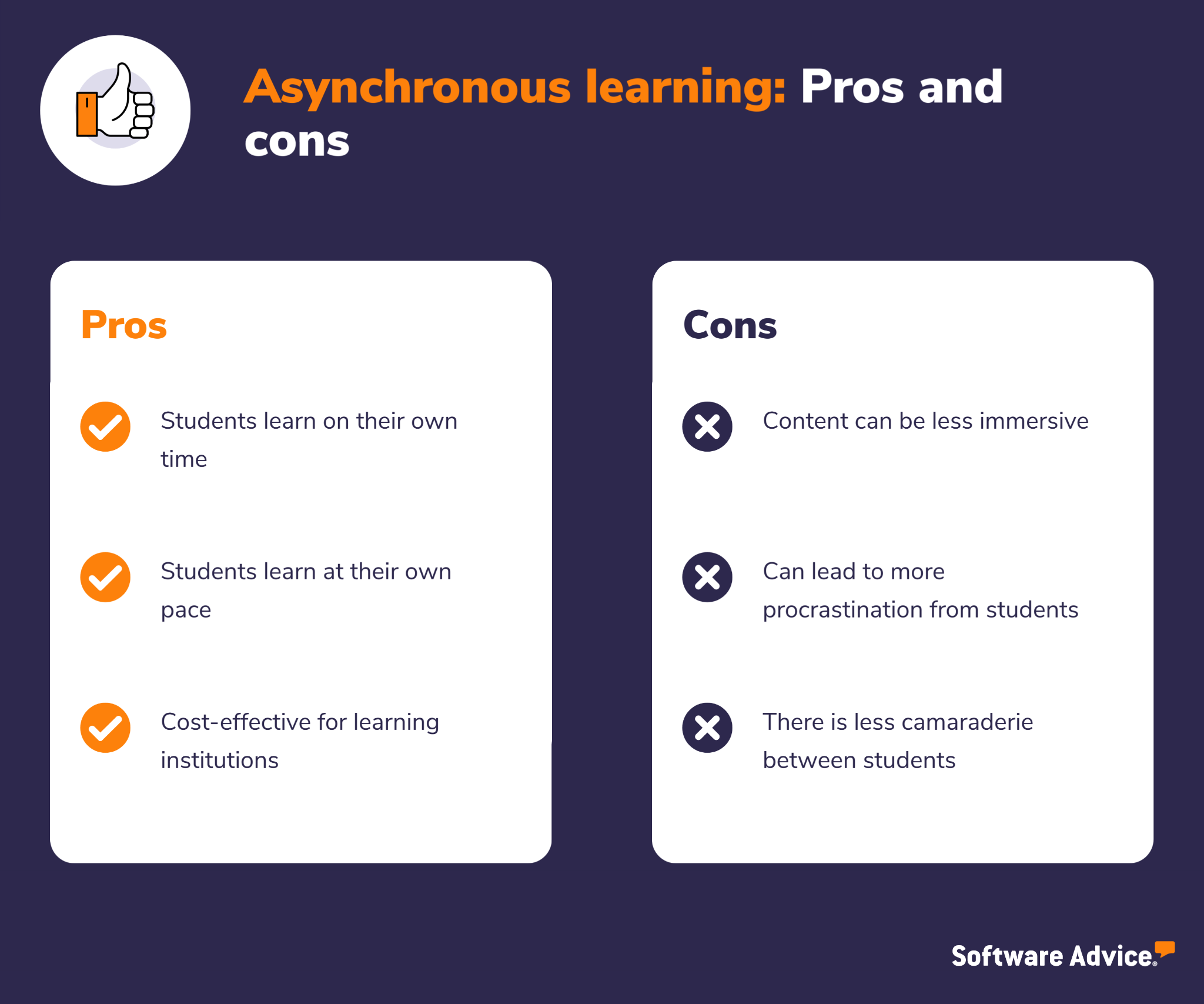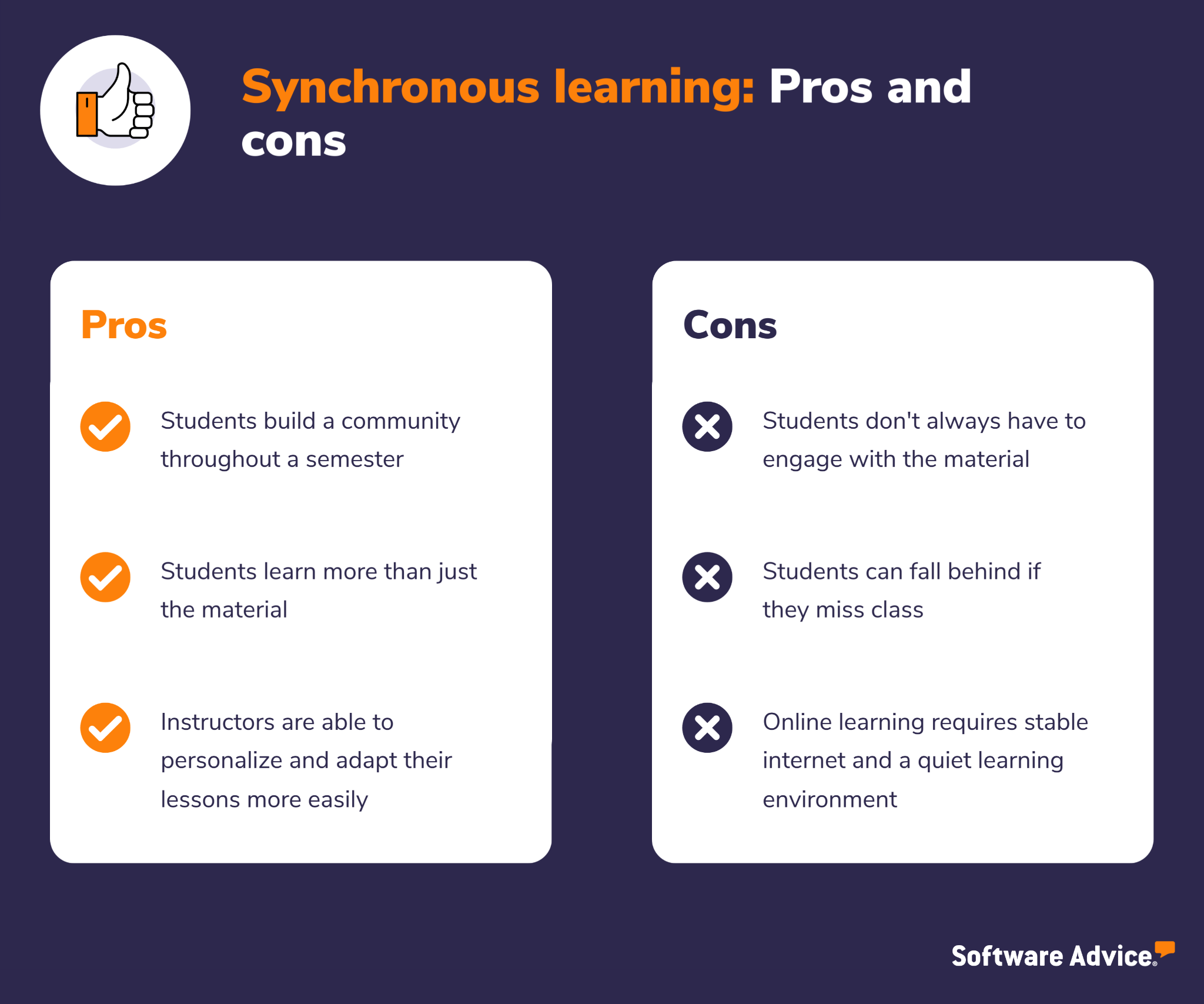Distance Learning: Asynchronous vs. Synchronous Learning
The sudden shift to remote learning using learning management systems forced many learning institutions and educators to rapidly adjust to meet students’ needs. It might be obvious, but what works for students learning in person isn’t the same as what works for online learning. That’s why course designers must now be more creative about how they provide their learning content, which means shifting away from traditional, synchronous learning.
Instead, instructors and educational institutions must employ a mixture of both asynchronous and synchronous learning to best suit the needs of their students. After all, the most effective type of learning is one that combines the agency and empowerment of asynchronous learning with the collaborative spirit and companionship of synchronous learning.
If you’re not sure what synchronous and asynchronous learning are, don’t worry: We’re going to break each term down and provide you with several examples and benefits. By the end of this article, you’ll understand why designing online courses with a mixture of both asynchronous and synchronous learning is the best move for your students.
What is asynchronous learning?
Asynchronous learning is a term used to describe forms of education, instruction, and online learning that do not occur in the same place or at the same time. Previously called distance learning, or asynchronous training, asynchronous learning has been around since the early 1900s and was done via the postal service.
Asynchronous learning can include:
Watching pre-recorded video lessons
Viewing video demonstrations
Reading and writing assignments at a student’s own pace
Quizzing students on required readings
Posting online class discussions via discussion boards
Benefits of asynchronous learning
The benefits of asynchronous online learning are numerous and an important part of any online course. In fact, asynchronous learning is useful for nearly all learning environments whether in-person or online.
A recent study found that when students received video lessons instead of the usual forms of synchronous teaching, the average grade increased from a B to a B+. Additionally, they found when students received video tutorials in addition to their existing classes, the effect was even stronger, moving students from a B to an A.
The study analyzed 105 past randomized trials with 7,776 students enrolled in higher education courses. Researchers examined the effects of videos on learning compared to the effects of other teaching mediums, such as in-person lectures and assigned readings.

Students learn on their own time
With asynchronous online learning, students gain the flexibility to learn at whatever time that works best for them or fits their schedule.
A learner doesn’t have to stress about making it to class on time because they are viewing pre-recorded lessons, doing readings, and completing assignments on their own schedule. For instance, a student might have a day job that prevents them from attending classes during a specific time.
Others might simply be the most engaged and active at non-traditional hours or might have transportation issues that prevent them from getting to the classroom in the first place.
The ability for students to be able to access learning materials on their own time is invaluable for all students, but necessary for some.
Students learn at their own pace
Students are able to engage directly with the material when learning asynchronously because they have control over the learning materials. If the material is challenging, a learner is able to pause the instruction to write notes, move back to a part they found confusing, or even re-listen to a lecture to make sure they understand.
Understanding the learning material can all happen in chunks which makes it particularly useful for students with attention problems who might miss important concepts during in-person instruction.
Don’t discount the empowerment that a student will feel by having control over their learning. Many students might never have been given the opportunity to engage with their learning in such a meaningful way before if they’ve only ever encountered traditional learning models or pedagogy.
Like many benefits of asynchronous learning, students being able to learn at their own pace is great for all students. However, some students need the extra time and flexibility because without it they might get left behind or not learn the material at all.
Cost effective for learning institutions
This one’s relatively simple. Instead of having to give the same lesson 4-7 times a day, an instructor can record their lesson once as a video for all of their sections with asynchronous teaching. This can free up the instructor’s flexibility and availability to their students who might have questions about the material. It also allows an instructor to perfect their lesson.
If they didn’t like how they presented the information, instructors can always re-record sections of the lesson before sending it off for students to engage with.
We know it’s easier said than done when it comes to introducing new technology into the classroom. That’s why Software Advice can ease your hesitancy and help with this transition through Video Making Software Buyers Guide. With video creation, editing, capture, and pre-made templates, this tool makes it easier for instructors to record videos ahead of time.
Challenges with asynchronous learning
It’s tough for many students and instructors to have a completely asynchronous learning environment. While it might be the ideal environment for some students, many will miss the camaraderie they share with their classmates, and face-to-face interactions and discussions about complex and challenging material often leads to a deeper understanding than online written discussion forums.
Additionally, students have a tendency to wait until the last moment to do assignments which is exacerbated with asynchronous learning.
What is synchronous learning?
Synchronous learning is real-time learning where students and teachers gather together at a set time and place. It’s what most people think of traditional school and has been the go-to type of instruction for nearly the entirety of education. Synchronous learning can include online classes as well.
Benefits of synchronous learning
There’s a reason synchronous learning has been the standard for so long. A dedicated space where students and instructors can meet to discuss learning material develops a sense of companionship and can foster an environment conducive to learning.
A recent survey found that 84% of students preferred synchronous learning over asynchronous learning because of its more immersive and social qualities. This further emphasizes the importance of ensuring students can form companionship with their fellow students.
Peers are able to discuss complex material together in order to gain a better understanding in real-time, and instructors have a greater finger on the pulse to know what they need to focus on.

Students build a community throughout a semester
Over the course of a semester or year, students build a community with their classmates and even their instructors that isn’t possible with asynchronous learning. This is especially true with in-person classes, but it even happens with online learning and distance learning as well.
Being able to break into peer groups to discuss material or work on complex problems together can lead to strong bonds being formed between students that strengthens their learning and provides a learning environment that isn’t available to a completely asynchronous learning course.
When students are comfortable being able to share their opinions and ideas, learning is more likely to happen, and students only become comfortable sharing their thoughts once they are familiar with their classmates.
Students learn more than just the material
Instructors always have a goal in mind when creating lessons, but some of the best learning happens when more organic conversations unfold around the material. With synchronous learning, students can engage with the material at the same time and place which means they can interrupt the lecture to ask questions which can lead to a more narrow, targeted discussion.
Additionally, students can break out into smaller groups to collaborate with each other. These more lively discussions aren’t possible with asynchronous learning, and some of the most memorable learning experiences happen this way.
Some of the best learning opportunities come from these spontaneous questions and discussions, which is something only synchronous learning can provide.
Instructors are able to personalize and adapt their lessons more easily
With synchronous learning, teachers can feel the pulse of the room and have a much greater idea about which parts of the lesson students understand and which they might need to spend more time reviewing. This doesn’t always happen naturally with asynchronous learning.
For instance, an instructor who notices a sea of confused faces when they go over part of a lesson might end up spending more time reviewing that confusing aspect. Some students might simply ask the teacher to spend more time on that part of the lesson.
Knowing where your students stand during and immediately after the lesson also helps instructors personalize and plan their lessons to best suit each class. Some classes might understand certain parts of the material better than others, so knowing where they need to focus helps make the learning experience better for their students.
Challenges with synchronous learning
Students aren’t always required to interact directly with the learning materials in a synchronous classroom. Unless participation is heavily enforced, it’s easy for some students to fall behind if they are uncomfortable asking questions in the class. Additionally, students might miss important details because they were unable to attend.
Many of the challenges are made much more obvious with synchronous online learning.
Let’s face it: online discussions are often choppy and hard to have in a meaningful way with a large group of students. While it has always been easy for some students to hide inside of a classroom and not participate in discussions, it’s made many times easier when the discussions are happening online.
One of the truly great benefits of synchronous learning is the organic conversations about learning materials that happen, and those are harder to have in large online classrooms.
Use asynchronous and synchronous learning when planning your courses to best enable your students
In the question of, “Which is better: Asynchronous vs. synchronous learning?,” the answer is somewhere in the middle. Overall, research shows that when synchronous learning features are used in conjunction with asynchronous learning, the course is more engaging, and learning outcomes are improved.
Asynchronous learning empowers students to learn at their own pace and on their own schedule while planning strategic synchronous learning opportunities allows students and their instructor to meet and discuss course material in-depth.
In an ideal hybrid online learning environment, you’d engage students with asynchronous coursework which prepares them for the synchronous meeting.
The hybrid classroom uses both asynchronous and synchronous learning to full effect:
Utilize asynchronous learning methods (like pre-recorded lessons, quizzes, readings, and discussion boards) to prepare students for meaningful synchronous meetings
Use synchronous learning to enhance the asynchronous learning methods by breaking students into small groups so that they can discuss what they have prepared. This leads to collaboration and a greater understanding of the material.
Students have an enhanced understanding of the material when they come to those strategic synchronized group meetings.
This hybrid approach brings the best of both worlds to the online classroom and allows every student the opportunity to participate in discussions.
And on that note, here are three tips for engaging students with an LMS in a hybrid learning environment:
Design a hybrid approach to learning for your students
Remote learning isn’t easy, but with a hybrid approach, you and your students can have a successful course. Check out the content below for advice and insights relevant to today’s unique learning environment for your students.